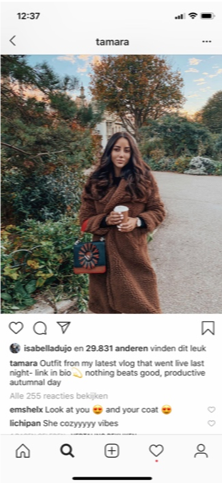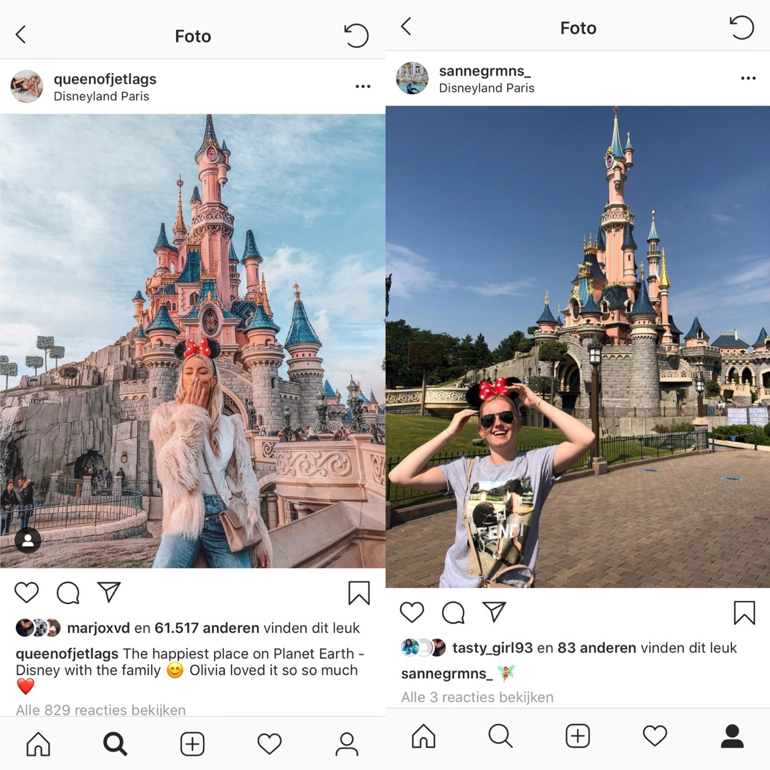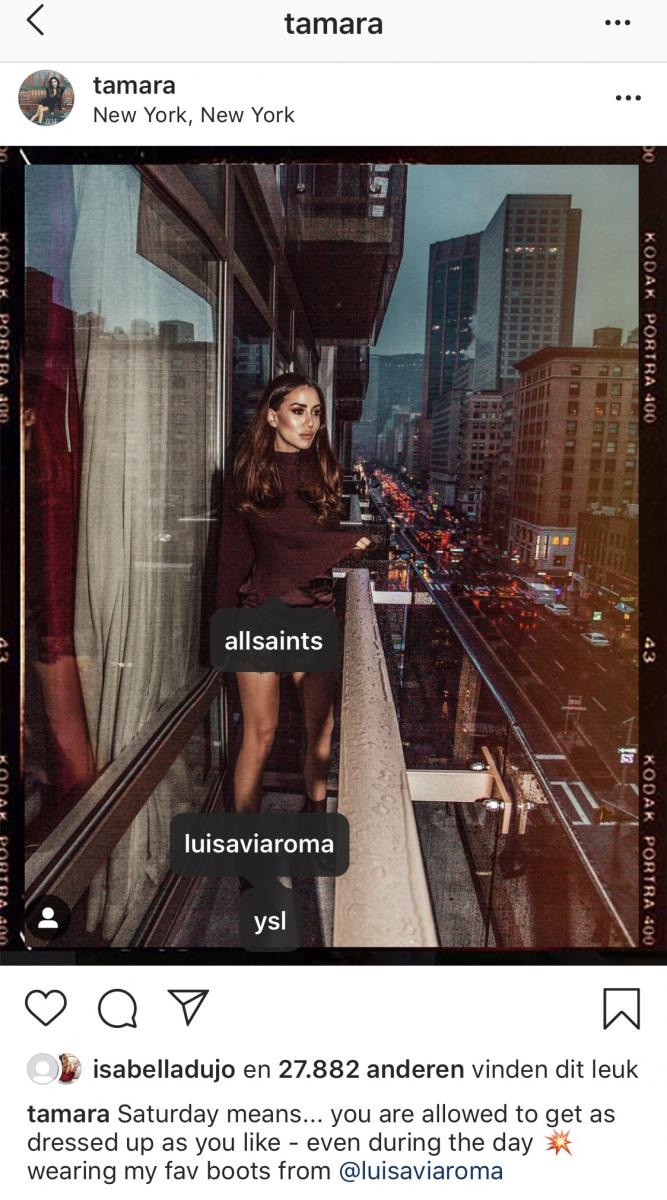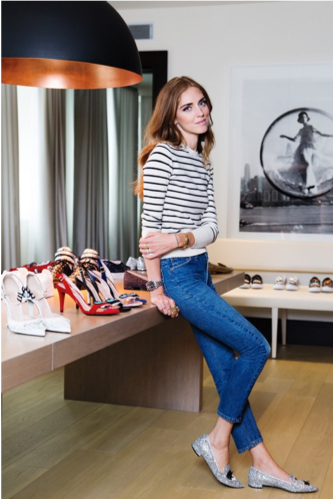
Understanding fashion instagram influencers as a social group
Influencers are winning, their popularity has taken off and they reach more followers every day. It is impossible to open your Instagram page without seeing at least one Fashion Instagram influencer, they are taking Instagram and influencing to a whole new level and they know exactly what they are doing. They have a strong connection with their millions of followers, their perfect outfits and their perfect lives, and it feels like they are your best friend, the one you go to when you need advice. Why do these Instagram fashion influencers have such established credibility and such a wide audience?
Fashion Instagram influencers
It seems like they can persuade others by virtue of their 'trustworthiness' and 'authenticity'. All influencers have their own 'wow' factor, and want to share their passion for fashion with the world. An important characteristic is that they appear to be themselves, or at least, 'look' like they are. Can we see these individuals together as a community, and if so, what are the similarities they share?
You can recognize fashion Instagram influencers who take their account seriously by their style, Instagram feed, and their online behavior. Their entire feed represents a personal brand and they are instafamous. Influencers are often the start of a new 'style'. The style of a fashion Instagram influencer can be commodified, but that does not make you a real influencer. It is the authenticity discourse that is important for the influencers. They are trendsetters, their brand is their life and who they are, and they are paid just to be 'themselves'. (Lopez, 2017) Influencers have a big impact on today's society and they are not only interesting for their followers but also for brands and companies: they know how to find influencers.
In the online community, there are all kinds of influencers. There are beauty influencers, such as Huda Kattan, who is seen as the most influential beauty blogger in the world, but also, travel, fitness or model accounts produce influencers. In this article, I will take a closer look at the Fashion Instagram influencers and zoom in on what makes someone a perfect influencer.
models.jpg

How do these influencers form a broader collective? Individuals shape their self-presentation, but they are also part of broader collectives that convey impressions of the whole group. Influencers on Instagram are both individuals and part of a collective. Their self-presentation is constructed through what they explicitly provide, through what their friends share, and as a product of how other people respond to them (Boyd, 2015). If the fans post comments below the photos of Instagram influencers, this affects their self-presentation. Impression management, online and offline, is not just an individual act; it is a social process.
As Queen of Jetlags states in an interview: “People who watch my vlogs know that I am not at all a representation of my Instagram profile, in my vlogs I show my real life, they see my house, the mess in the living room, I am far from perfect but on Instagram I can show my ideal self. My Instagram is as a kind of Museum for me, I watch with a trained eye and I show art in my pictures”. (Queen of Jetlags, 2018)
I am at home in both worlds
For many millennials, it is the ultimate goal to be instafamous or to become an influencer on Instagram. If you google “How do I become a Social Media influencer” you get tons of articles on how you can become one. The first steps are to find your niche, to grow your network, and to engage with your followers. Does not sound that hard, right? But still, not everybody who tries gets recognition as a real influencer.
The quality of the posts must be outstanding, a lot of thought has to go into one picture, As QueenOfJetlags stated in an interview:
The making of a perfect Instagram picture can take days off work, planning this pictures is the key to success
She continuous with: “I can search for hours for a perfect location and a perfect outfit.” People may not realize that influencing on any scale is a fulltime job. Your account needs to be up to par and your success as a social media personality lies in your photography skills and your online activity. Instead of thinking in terms of individual shots, your entire feed should represent your personal brand. As for the online activity, you need to post consistently and engage with other users’ content. This means you also engage with other Instagram influencers, and leave a nice comment when they post a photo. In this way, they can engage more followers and achieve higher name awareness.The main appeal of influencers is that they command a certain level of expertise, coupled with the high engagement rates of a known face who is not above making genuine connections. (Sweeney, 2018)


Identity emblems and the perfect Instagram feed
Instagram influencers are easily recognized. They post several posts per week, often the post is edited, and the Instagram feeds are perfect.
Collage Instagramfeed
They have put a lot of effort into their Instagram feed. Their feeds are color-based, for example. They may use a base color and gradually move from one highlight color to the next.
There are various identity markers that characterize the fashion influencer. They always wear something new or cool. This can be a designer item but it is also possible that these are secondhand clothes or basic Zara clothes - as long as it is fashionable. The pictures must be perfect, the pictures are semi-spontaneous: They pretend it is a spontaneous photo while in reality they may have posed for a hundred pictures. Most of the time, the photos are taken by someone else and as mentioned before, they are almost always edited. Their identity is a matter of ‘enoughness’; one has to have a display and enact ‘enough’ of the emblematic features in order to be ratified as an authentic member of the category (Maly, pp. 4-5). Enoughness is by its very nature a field of contestation and debate. Communicating one's authentic self to others is, thus, a matter of striking the delicate balance between 'too much' and 'too little' so as to achieve 'enoughness' (Blommaert, 2011).
Fashion influencers as micro-celebrities
Another key success for influencers is to approach their audience not only as fans but also as friends. No matter how much effort you put into your feed, or how cool you look and how beautiful your pictures are, if you don't seem genuine or friendly, it will not work. Followers need to have the idea that they really 'know you', know all your flaws and your characteristics, while at the same time they should look up to you. How influencers show themselves as a person is part of the social process. Influencers use a self-presentation technique in which people view themselves as a public persona to be consumed by others, use strategic intimacy to appeal to followers, and regard their audience as fans (Marwick and Boyd, 2011).
Noor de Groot, also known as QueenofJetlags, is a famous Instagram influencer from The Netherlands. She sttarted out in 2013 with her own blog, in 2015 she won the blogLovin award and Zalando best fashion blog award (Ismay, 2017), and today Noor has 724.000 followers on Instagram and vlogs for about 99.000 subscribers on YouTube. Every year, she hosts a Closet Sale for her fans. They can buy a ticket for ten euros and it is an opportunity for the fans to buy her old clothes and take pictures with Noor. It is the ultimate moment for her and her followers to bond. For fans, it is much easier to connect with somebody like Noor than with other celebrities like singers or actors.
IMG_8181.jpg

Instagram influencers and imagined communities
Influencers start trends, but what they post may also somehow become normal. They start communities, as what they do or do not do is followed by many people who see the influencers as their examples. It is an imagined community (Benedict Anderson, 2006): members will never know most of their fellow-members, yet in the minds of each lives the images of their joint communication.
In a recent article 'The supposed authenticity of Social Media celebrities', Aniek van den Brandt argues that everybody can be a social media celebrity. After all, they are authentic and just like you. Or rather, that is what they want to make you believe. She continues: When looking at different social media celebrities, one will find that the content on their social media is more or less similar. The faces differ, but there seems to be a certain standard for being authentic.
Every Social Media celebrity or influencer tries to be authentic, but the content on their platforms is more or less similar. They try to convince you of their authenticity, but in the end, they have a big group of followers and to be liked by all of their followers the content has to be mainstream.
People use the media to create these imagined communities; the media enable this through targeting a mass audience or generalizing and addressing citizens as the public. Another way that the media can create imagined communities is through the use of images. The audience will choose which image they relate to the most. Instagram is in this way also a platform where people can create imagined communities. Instagram shows you whatever they think you like to see and you can identify yourself with that kind of content.

Fashion influencers and the performance of scripted identities
While influencers try to convince you of their authenticity, and thus differentiate themselves from other influencers, they also need to conform to a prototype. They act in a certain way to be part of the group of influencers, so that they can be recognized as 'influencers'. They do not always succeed.
This performance of identity is constructed in relation to the interfaces and algorithmic ecology of their medium of choice. They have a scripted identity: within computational ecologies, users may register or subscribe to certain identity templates, formats, or ideal types - and conversely, to cast off any alternatives (Van Nuenen, 2016).
Because of filter bubbles and personalization influencers act in a way that resembles other influencers. They think they should act in a certain way in order to be an influencer. Everything the influencer does is clearly thought about beforehand, as they manage their online identity.
Another aspec of the scripted identity of the influencer concerns the connection with followers. Interaction with fans makes fans feel special, as it may feel like influencer and fan really know each other. Influencers talk to fans like they are their best friends. Fans' comments affect their self-presentation. This way influencers show that they care about their followers, and in the meantime they ensure they keep their Instagram active. Everything is connected and part of the social process.
“Who is wearing denim today?”, “How would you describe me in 3 words?”, and “Who else is obsessed with winter?”. Three examples of connecting with followers when you go on an influencer's Instagram page. Instagram influencers function as “Masters” or crusaders within their cultural niche (Becker, 2008). They have a massive number of followers and introduce products and styles, often working together with a brand.
Instagram examples question
Fashion Instagram influencers as a micro-population
Instagram influencers come from all around the globe but all present themselves in English. The fashion they show, likewise, is from all over the world, from expensive designer clothes to affordable Zara clothes that you can buy in every city. Influencers are recognizable on a global scale, but as a social group they are multi-layered and polycentric: what is labeled as 'influencers' differs depending on who uses the concept and in which part of the world they live (Maly & Varis, 2015).
'Micro-population' is a concept introduced by Maly and Varis (2015) to make sense of group construction and identity formation in times of digitalization and (neoliberal) globalization. According to them, micro-populations are polycentric, layered and transnational groups. They group people together with their ‘style’, by the places where they hang out, and the places where you cannot find them.
Influencers are mini niche market celebs. Technically, they are a brand, but instead of curating editorial content through a website, they promote 'their' lifestyle on social media. These individuals have a certain level of expertise in a specific niche. An influencer is 'passionate' and 'authentic' – someone with a relationship with their followers who is seen as a go-to source for information and recommendations. (Sweeney, 2018)
Being an influencer is not enough
There is more to being an influencer than posting Instagram photos. Most of the influencers have started their own company, their own line within another company or they star in campaigns. It is a commodified niche; highly commercialized, the influencer is not 'influencing' for free. There are brands that pay influencers to show their products or to work together. The fashionista's are promoting mass brands and Instagram is the perfect platform to do so. The influencer may tag the brand in a picture or even name the brand in the caption.
In a recent article The Romance of Work, the writer argues that many of the activities these young influencers engage in can be conceptualized as aspirational labor: Forward-looking, carefully orchestrated, and entrepreneurial forms of creative cultural production. Their Instagram represents a way to showcase their talents and passions to the public in a way that opens up various career possibilities.

As Chiara Ferragni stated in an interview with the Guardian: “I started as a blogger, but it is not so much that anymore, I do so much more”.
We are business people, not just crazy bloggers
She is the boss of TBS crew, a media company. Her net worth is well above the average influencer or celebrity. Chiara also has her own shoe collection named after her. She is not the only influencer with her own company. Another example is Negin Mirsalehi, the influencer of the year, who started her own hair-care brand Gisou. Last year, Gisou did almost three million in sales, while she continued to make 20.000 dollars per sponsored Instagram post, thanks to her over four million followers.
Afbeelding8.png

The final presentation of fashion Instagram influencers
Let's summarize what we have learned from influencers so far. The fashion influencers take their Instagram account seriously. There even is an award for the 'influencer of the year'. You can recognize an influencer by their style, their Instagram feed, which most of the time is Color-based, their online behavior, such as posting every week, and they way they interconnect with other influencers and fans. Instagram influencers come from all around the globe and have an international audience.
The Instagram influencers function as 'masters' or crusaders, they have a massive number of followers. They present themselves as micro-celebrities: they use a self-presentation technique in which people view themselves as a public persona to be consumed by others, use strategic intimacy to appeal to followers, and regard their audience as fans (Marwick and Boyd, 2011). They want you to look up to them, but also imagine you as their friend. Being an Instagram influencer is a full-time job, the making of the perfect Instagram picture can take days of work. Your account needs to be up to par and your success as a social media personality is based on your photography skills and your online activit: your entire feed should represent your personal brand.
That personal brand and the associated identity is a matter of 'enoughness'. It is about communicating one's authentic self (Maly, pp. 4-5). Every Social Media celebrity or influencer tries to be authentic, but the content on their platforms shows a lot of similarities. They try to convince you of their authenticity, but in the end, they want a big group of followers and in order to be liked by all of their followers the content has to be mainstream. The influencer's example is followed by many people. In the end, it is the authenticity discourse that is important for influencers.
References
30 under 30. (2018, January 21).
Becker, H. (2008). Outsiders.
Benedict, A. (2006). Imagined Communities.
Boyd, D. (2015). Impression Management in a Networked setting. In D. Boyd, Impression Management in a Networked Setting (pp. 122-126).
Blommaert, J. (2011) Enough Is Enough: The Heuristics of Authenticity in Superdiversity
Duffy, B. (2015). The romance of work: Gender and aspirational labor in the digital culture industries
Gourdon, A. (2018, November 13). Influencer of the Year.
How Chiara Ferragni earned more media value than Meghan Marckle. (2018, September 6).
How Chiara Ferragni's blog became an $8M business. (2015, March 23).
Instafamous. (2012, September 24).
Ismay. (2017, Oktober 21) In de spotlight: Noor de Groot.
Lopez, A. (2017). What's the difference between a fashion blogger and an influencer.
Maly, V. A. (2015). The 21st-century hipster. European journal of Cultural studies, 4-5.
Marwick and Boyd (2011, 19 May) To See and Be Seen.
Pormann, E. (2003). Mainstream. Retrieved from Urban Dictionary.
Queen Of jetlags. (2018, November). Linda Meiden, p. 161.
Sweeney, G. (2018, November 8). How to become a micro-influencer on Instagram.
Van Nuenen. (2016)